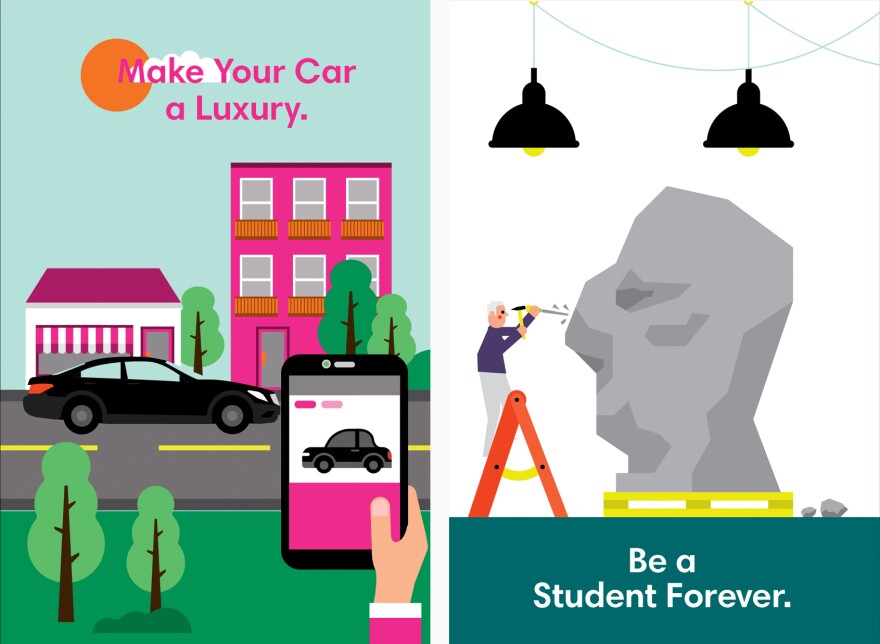When Architect Matthias Hollwich was approaching 40, he wondered what the next 40 years of his life might look like. He looked into the architecture that serves older adults, places like retirement communities and assisted living facilities, and didn't like what he saw. But what if we changed our habits earlier in life so we could stay in the communities we already live in?
"Retirement communities sounded great when they were created, but now when you retire, you may live there for 30 or even 40 years," he says. "You play golf and bingo; [you're] not really part of the general society."
Hollwich, a visiting professor at University of Pennsylvania, discussed the idea with students and faculty. They created a conference on aging to talk about how adults could continue to engage with society as they got older. Maybe a nursing home could turn into a healthiness hub, or an informal volunteering app could provide support to older people
Even though Hollwich began by thinking about architecture, he realized that people need to create a social structure that supports them, too.
So he and his architectural firm, HWKN, partnered with Bruce Mau Design to compile ideas in a bright, friendly book, New Aging, published last week by Penguin Books. The book serves as a guide for thinking about aging much earlier. Hollwich, now 44, spoke with Shots about his ideas on the architecture of aging. The conversation has been edited for length and clarity.
Why do you think it's important for people to start thinking about aging while they're still young?
Statistics show that older people move three times in the last three years of their life. They move from a place where they may want to live, like in Florida. They move closer to family when the first big issues appear within the health and social context. They lose all their social contacts because they're moving and changing their environment. [Then] maybe they break a leg. Now they don't have proximity to friends who can help them, so they need to move into an assisted living facility or nursing home.
We need to make sure that we nurture the social surrounding around us so we have friends and a safety net. This comes through personal contact.
We also have to look at our houses, where we live, and make sure that these buildings don't become traps. It's just too late to renovate your bathroom when you have a physical deficit.
What kinds of social adjustments do you think people should make in their community?
It's really about re-engaging with our community around us and creating strategic alliances between people. Think about it. What can be done better within communities, within retail or service offerings that allow us to live our whole lives in more rural areas? That needs awareness, planning, and the fearlessness of addressing aging to make adjustments.

In a high-rise building, most people never talk to their neighbors. As soon as you do, [you can] share some of your stories or responsibilities. You help them go shopping, or maybe one of your neighbors cooks for you one day. For us as architects, it's really important that we design apartment buildings entirely different than we do today; that we provide spaces that create social glue between people — not in a forced way but in a much more playful way.
What kind of spaces bring people together?
When you think about a hallway, it's used to go from your elevator to your apartment. But if you widen it up and create some seating areas or a shared kitchen, you might create a connection. Maybe someone comes by late in the evening and you're sitting there reading a book and they say "Hi. Oh, what are you reading?" You have this conversation and you start to make friends. These things are social offerings in a building, almost like a front porch. You sit there and you can wave to your neighbor and make contact. That creates familiarity and a social bond.
Do you have a favorite point in this book?
The chapter "Never Retire" is something that sounds to most people as kind of horrible. Most people look forward to retirement, but it's a big mistake. It's important that you have a meaningful contribution to society. Of course it doesn't have to be a 9 to 5 job. It could just be something you do once a week or for a few hours here and there. There's a whole boomer population that is starting up businesses after official retirement.

Where do you see yourself at 80 or 90?
I see myself creating a strategic alliance with some of my friends. We've already started to talk about it. We want to live in close proximity or even in the same building. And it will be in a building that is entirely diverse in terms of ages, because the worst thing is when you get older, society just provides buildings for "old people." It's not healthy. It's important that when we get older you're mixed with all generations. That's a part of the vitality that helps in life.
People should look at the aging process as starting up a business. It would be helpful for people to pick a board of directors for your own life. Get four to five people in a room that you really trust and tell them what you plan to do in different stages of getting older. Let them be your steering committee and your sounding board so you can do the right things in terms of navigating your life.
I really believe it's important that we have to start sharing our thoughts and plans with each other. Everyone has these thoughts, but everyone keeps it very private. As a community you're much stronger and we can help each other.
Copyright 2023 NPR. To see more, visit https://www.npr.org.



